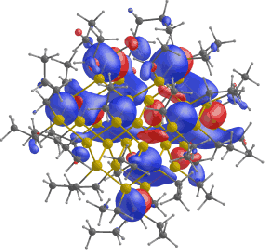Silicon nanocrystals

Illustration of the highest-occupied molecular orbital of a 1nm diameter silicon nanocrystal capped with a C2H6 monolayer
Studies into the properties of silicon nanocrystals are an active research field within the Group. Nanocrystals (or quantum dots) are synthesized through via 'top-down' techniques from bulk nanoporous silicon and bound by an alkyl capping layer. From a combination of small-angle x-ray scattering (SAXS), transmission electron microscopy (TEM), scanning tunneling microscopy (STM), and atomic force microscopy (AFM) their diameters are aprroximately 2.2 ± 0.4 nm.
Current research projects investigate their luminescent and electronic and structural properties with view to utilising them as cellular and genomic probes in biological and medical applications through attchment to DNA.
Recently, with the Chemical Nanosciences Group, we have successfully evaporated silicon nanocrystals at low temperatures (~200 °C) in an ultra-high vacuum environment, and collected the resulting vapour onto various solid substrates. This behaviour may be useful for the controlled preparation of films of quantum-confined silicon structures with a variety potential applications in industry.
Our Publications
- Šiller L, Krishnamurthy S, Kjeldgaard L, Horrocks BR, Chao Y, Houlton A, Chakraborty AK, Hunt MRC
Core and valence exciton formation in x-ray absorption, x-ray emission and x-ray excited optical luminescence from passivated Si nanocrystals at the Si L-2,L-3 edge
JOURNAL OF PHYSICS-CONDENSED MATTER 21 095005 MAR 2009 - Coxon PR, Chao Y, Horrocks BR, Gass M, Bangert U, Šiller L
Electron energy loss spectroscopy on alkylated silicon nanocrystals
JOURNAL OF APPLIED PHYSICS 105 Art. No. 084318 OCT 2008 - Chao Y, Šiller LS, Krishnamurthy S, et al.
Evaporation and deposition of alkyl-capped silicon nanocrystals in ultrahigh vacuum
NATURE NANOTECHNOLOGY 2 (8): 486-489 AUG 2007 - Chao Y, Houlton A, Horrocks BR, et al.
Optical luminescence from alkyl-passivated Si nanocrystals under vacuum ultraviolet excitation: Origin and temperature dependence of the blue and orange emissions
APPLIED PHYSICS LETTERS 88 (26): Art. No. 263119 JUN 26 2006
- Chao Y, Krishnamurthy S, Montalti M, et al.
Reactions and luminescence in passivated Si nanocrystallites induced by vacuum ultraviolet and soft-x-ray photons
JOURNAL OF APPLIED PHYSICS 98 (4): Art. No. 044316 AUG 15 2005

